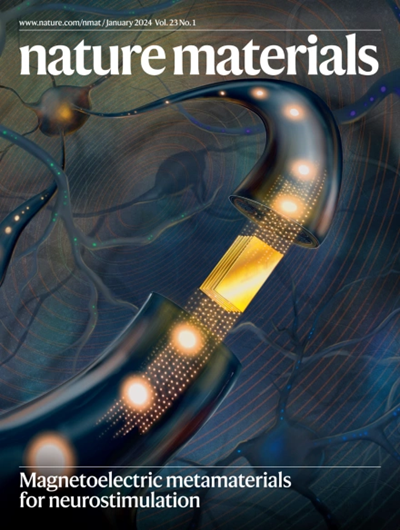用于高性能稳定钙钛矿太阳能电池的非富勒烯电子传输材料
IF 38.5
1区 材料科学
Q1 CHEMISTRY, PHYSICAL
引用次数: 0
摘要
电子传输材料(ETM)是钙钛矿太阳能电池(PSCs)优化电子从钙钛矿向阴极萃取的关键组成部分。富勒烯,特别是C60和[6,6]-苯基- c61 -丁酸甲酯(PCBM),已被用作倒转psc的基准etm。然而,C60仅限于热蒸发,而PCBM光热稳定性差,电子输运欠佳,限制了其PSC应用。在这里,一种可溶液处理的非富勒烯ETM,基于氰基功能化双噻吩亚胺二聚体(CNI2)的聚合物(PCNI2-BTI)具有多种优点,包括优异的光热稳定性,高效的电子传递以及与钙钛矿层的改善相互作用。因此,含有PCNI2-BTI的倒置PSCs具有出色的功率转换效率(PCE)为26.0%(认证为25.4%)和卓越的运行稳定性,在iso - l -3标准下T80接近1,300小时。此外,我们还合成了另外三种基于cni2的聚合物etm,在psc中产生的平均PCE为25%。这些发现表明,非富勒烯etm具有前所未有的潜力,可以实现高性能和稳定的psc。本文章由计算机程序翻译,如有差异,请以英文原文为准。


Non-fullerene electron-transporting materials for high-performance and stable perovskite solar cells
The electron-transporting material (ETM) is a key component of perovskite solar cells (PSCs) optimizing electron extraction from perovskite to cathode. Fullerenes, specifically C60 and [6,6]-phenyl-C61-butyric acid methyl ester (PCBM), have been used as the benchmark ETMs for inverted PSCs. However, C60 is restricted to thermal evaporation, and PCBM suffers from poor photothermal stability and suboptimal electron transport, limiting their PSC applications. Here a solution-processable non-fullerene ETM, cyano-functionalized bithiophene imide dimer (CNI2)-based polymer (PCNI2-BTI), holds multiple advantages, including excellent photothermal stability, efficient electron transport and improved interaction with the perovskite layer. Consequently, inverted PSCs incorporating PCNI2-BTI deliver an outstanding power conversion efficiency (PCE) of 26.0% (certified 25.4%) and remarkable operational stability, with a T80 approaching 1,300 h under ISOS-L-3. Moreover, we synthesize three additional CNI2-based polymer ETMs, yielding an average PCE of >25% in PSCs. These findings demonstrate unprecedented potential of non-fullerene ETMs enabling high-performance and stable PSCs. The benchmark fullerene-based electron-transporting materials (ETMs) for inverted perovskite solar cells are often limited by thermal evaporation or stability issues. Here the authors report solution-processable non-fullerene ETMs with improved device stability and efficiency.
求助全文
通过发布文献求助,成功后即可免费获取论文全文。
去求助
来源期刊

Nature Materials
工程技术-材料科学:综合
CiteScore
62.20
自引率
0.70%
发文量
221
审稿时长
3.2 months
期刊介绍:
Nature Materials is a monthly multi-disciplinary journal aimed at bringing together cutting-edge research across the entire spectrum of materials science and engineering. It covers all applied and fundamental aspects of the synthesis/processing, structure/composition, properties, and performance of materials. The journal recognizes that materials research has an increasing impact on classical disciplines such as physics, chemistry, and biology.
Additionally, Nature Materials provides a forum for the development of a common identity among materials scientists and encourages interdisciplinary collaboration. It takes an integrated and balanced approach to all areas of materials research, fostering the exchange of ideas between scientists involved in different disciplines.
Nature Materials is an invaluable resource for scientists in academia and industry who are active in discovering and developing materials and materials-related concepts. It offers engaging and informative papers of exceptional significance and quality, with the aim of influencing the development of society in the future.
 求助内容:
求助内容: 应助结果提醒方式:
应助结果提醒方式:


